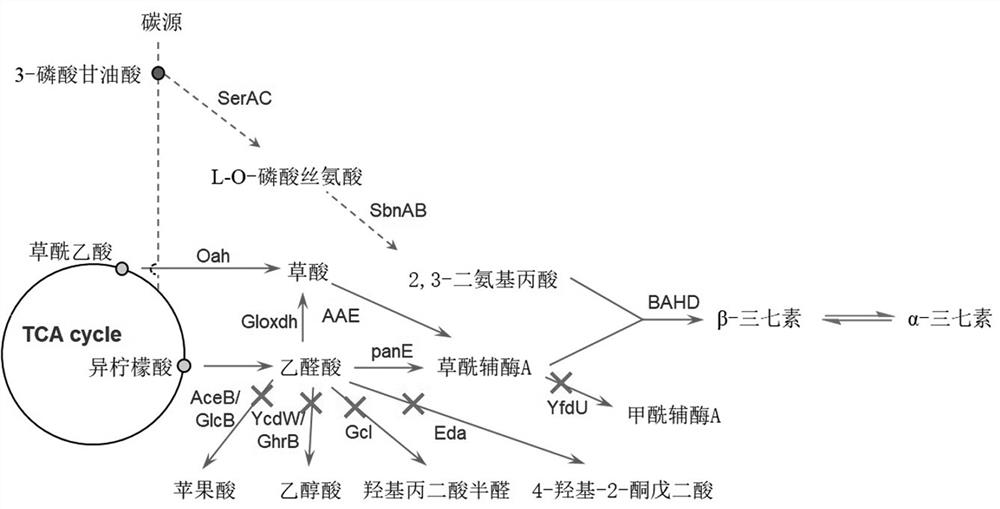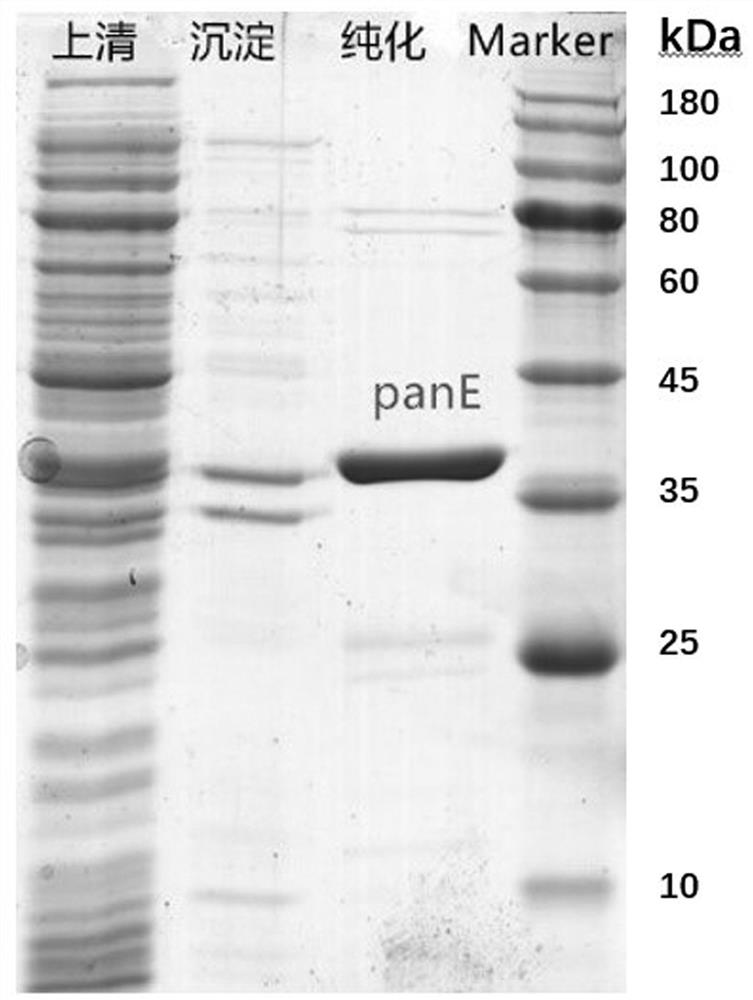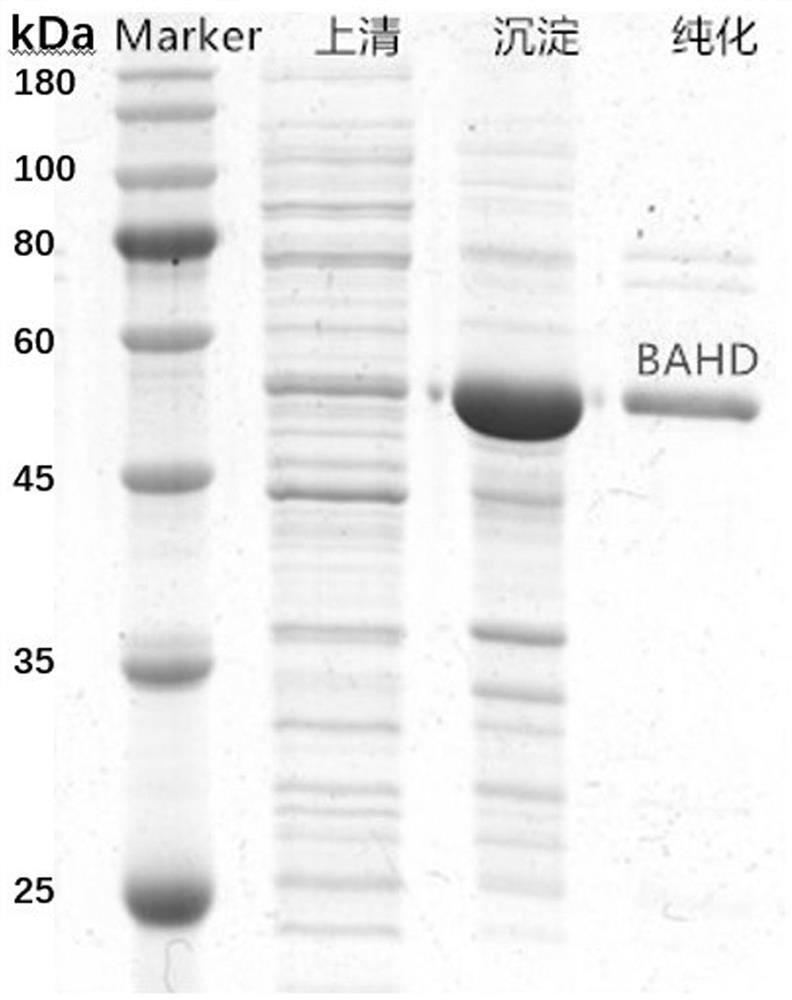Engineering bacterium for synthesizing dencichine and application
A technology of Panax notoginseng and engineering bacteria, which is applied to bacteria, enzymes, microorganism-based methods, etc., can solve the problems of tedious steps, low yield, and large environmental pollution problems of Panax notoginseng, and achieves simple method and high conversion rate. , the effect of low cost
- Summary
- Abstract
- Description
- Claims
- Application Information
AI Technical Summary
Problems solved by technology
Method used
Image
Examples
Embodiment 1
[0053] Expression, purification and enzyme activity assay of embodiment 1panE
[0054] According to the acylated glyoxylate dehydrogenase gene published by NCBI sequence ID: WP_015822665.1, the gene fragment was obtained by chemical synthesis, and the recombinant plasmid pET-panE was constructed with BamHI and XhoI restriction sites; positive transformants were selected and transformed into BL21 (DE3) Competent cells, spread the transformation mixture on a solid LB plate, incubate at 37°C for 12 hours, pick a single colony and inoculate it into an LB ampicillin-resistant medium test tube, and incubate in a 200rpm constant temperature shaker at 37°C for 8 hours, According to the volume fraction of 1% to 10%, the inoculum was transferred to a Erlenmeyer flask containing 100mL LB ampicillin resistance medium, cultured at 37°C in a constant temperature shaker at 200rpm for 2h, and the inducer isopropyl-β-D-sulfur was added Substitute galactoside (IPTG) to a final concentration of ...
Embodiment 2
[0056] Expression, purification and enzyme activity assay of embodiment 2BAHD
[0057] The genome and transcriptome were extracted from selected bacteria, molds or plants, and compared with the known N-acylase sequence, it was preliminarily determined that it can catalyze the formation of 3-D from 2,3-diaminopropionic acid and oxalyl-CoA. The enzyme of Qisu is named as 2,3-diaminopropionic acid N-oxalyltransferase BAHD, and its sequence is shown in SEQ ID NO.1. The codon-optimized gene fragment was obtained by chemical synthesis, and the recombinant plasmid pET-BAHD was constructed with BamHI and XhoI restriction sites; positive transformants were selected and transformed into BL21 (DE3) competent cells, and the transformation mixture was spread on solid LB On the plate, cultivate at 37°C for 12 hours, pick a single colony and inoculate it into a test tube of LB ampicillin-resistant medium, culture it at 37°C in a 200rpm constant temperature shaker for 8 hours, and transfer it...
Embodiment 3
[0059] Expression, purification and enzyme activity assay of embodiment 3 Gloxdh
[0060] According to the glyoxylate dehydrogenase gene published by NCBI sequence ID: BAH29964.1, the gene fragment was obtained by chemical synthesis, and the recombinant plasmid pET-Fpgloxdh was constructed with BamHI and XhoI restriction sites; according to the published by NCBI sequence ID: BAH29964.1 The glyoxylate dehydrogenase gene sequence was compared with other sources, and the comparison results showed that the Cyb2p gene derived from Saccharomyces cerevisiae, NCBI sequence ID: AJS66626.1, had 50.30% homology with Fpgloxdh, and was named Sagloxdh. Using the Saccharomyces cerevisiae genome as a template for PCR, the recombinant plasmid pET-Sagloxdh was constructed with EcoRI and XhoI restriction sites. Select positive transformants and transform them into BL21(DE3) competent cells, spread the transformation mixture on a solid LB plate, incubate at 37°C for 12 hours, pick a single colony...
PUM
 Login to View More
Login to View More Abstract
Description
Claims
Application Information
 Login to View More
Login to View More - R&D
- Intellectual Property
- Life Sciences
- Materials
- Tech Scout
- Unparalleled Data Quality
- Higher Quality Content
- 60% Fewer Hallucinations
Browse by: Latest US Patents, China's latest patents, Technical Efficacy Thesaurus, Application Domain, Technology Topic, Popular Technical Reports.
© 2025 PatSnap. All rights reserved.Legal|Privacy policy|Modern Slavery Act Transparency Statement|Sitemap|About US| Contact US: help@patsnap.com



